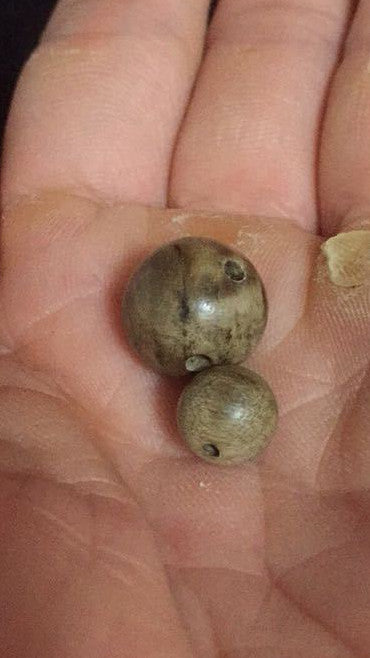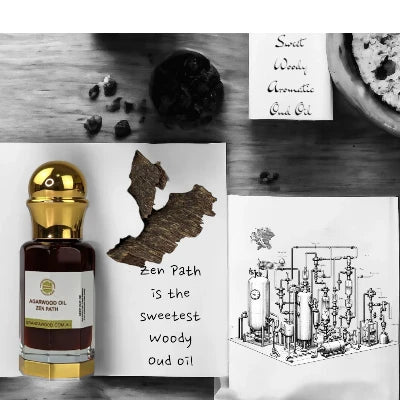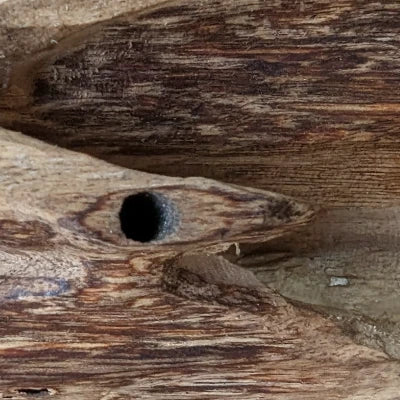Menu
-
-
F.A.Q
- How to identify genuine agarwood chip, natural or cultivated
- How to identify oil injection / absorption fake agarwood beads
- How to know if there are more than one oil in your oil
- How to make your wood bracelet or mala darker
- How to tell if an Agarwood bead sinks WITHOUT sinking it under water?
- How does back flow incense work and how do you burn it?
- Where to start if you don't know what agarwood is ?
- Why are you losing money if you buy seeds and plants?
- Which agarwood incense should I choose?
- Frequently Asked Questions
- Agarwood Related Articles
- Shipping
-
SHOP - Agarwood
-
SHOP - Other Fragrant Wood
-
SHOP - Incense Holder and Burner
-
- FREE guide book
- Testimonials
- "Why did you buy this?"
- Contact us
- About Us
- +61430284329
- Login
-
English


Rescue a damaged 108 Agarwood mala - an attempt to repair
December 26, 2017 4 min read
Below is the original finish of the agarwood 108 mala.

An accident

D (not real name) bought this mala. After wearing it several months, he accidentally left it in his trouser pocket. He was so busy with work, and he forgot about it.
A day or two later, his wife did the laundry routine. Without knowing the mala was inside his pocket, she loaded everything in the basket into the washing machine. Then she added detergent, selected the wash option and pressed "start".
The wash cycle was for 1 hour. And after that, it beeped.
D took the load out in another basket and walked out the balcony to dry the family clothes.
He hung one piece next to another line by line. During that process, he reached his trousers and reverted inside-out so it would dry faster.
Suddenly, he felt something was in his left pocket.
Pulled it out, he realised that was his wild agarwood mala and it is not water-resistant. It was worth thousands.
"Dammmmmmm"
Yep, I felt his pain. The damage had been done by water and the detergent.
Why?
Water is necessary for any living organisms.
In nature, tree love water. However, when people cut a tree down and make use out of it, it becomes deadwood.
And deadwood does not like water.
That is the reason why all woods used in building, construction, fencing are treated to they can last under the rain, and sun.
If the untreated wood contacts water, it will expand. When water vaporises, it will cause cracks on the surface.
Water can also stain the furniture, cause wood to rot, mould to grow.
About agarwood
Agarwood is soft and people will not use it for furniture. If you go to a hardware store, you can only find "hardwood". If you asked a service staff about "softwood", they would not wonder why you need a softwood?
Because softwood is not suitable for building, furniture making
But softwood is still wood and wood does not work well when it contacts with water.
Agarwood is non-timber wood. It is so soft that you can leave a mark if you use your finger to press again it.
People use agarwood because of its aroma. So it will not be painted, or water-proofed.
When agarwood contacts with water for a while, it will be damaged.
Why do I tell you this?
Let's go back to the story of D
Here was what D found out what was left inside his pocket.


From the above pictures, the mala looked dead, just like dead coral. However, the agarwood aroma was still strong. Interestingly, it was even stronger after washed compared to before washed. And it was not the detergent smell.
This particular 108 mala is $3000 AUD worth and was made of high-quality agarwood.
D contacted us.
Could we "revitalise" it?
An acceptance to repair
"It is what it is" we can't change the past. What happened already happened. Yes, we wished we could turn back in time. Our heart sank when we opened the package.

Surprisingly, after going through the ordeal, the agarwood scent from the mala is still present and very NOTICEABLE, despite the worn-out look. It is the inside that count: the resin content.
After receiving it from D, we de-stringed the beads and ran them under bead making machine. After buffing and polishing, we polished each bead one by one by hand. This action is to revive the glossy look.
Below is the bead polishing machine. Please note the beads in this image were not the same damage beads in this case. The purpose of this image is for illustration only.

It is a time-consuming project, but it is worth it for a "damaged" masterpiece.


There was a lot of oil from the guru bead, as you can see, the resin appeared and melted again. The scent was so strong. It was a similar experience of burning an agarwood chip.
After hours and hours of buffing and spinning, we have successfully recovered this beautiful agarwood mala. The most challenging part was to apply the right force. Agarwood beads are incredibly soft and easily cracked under pressure. In this case, we did not have a spare one. Ruin one bead means the whole necklace could be left damaged
One by one, each bead was polished with extreme care as there is no replacement.

We proudly represented the bead to our customer, who was happy with its new look. Better yet, the scent was somehow stronger than before
German philosopher, Friedrich Nietzsche. said once said: "..that which does not kill us, makes us stronger". In this case, it was for this mala. The water did not "kill" the bead. It made its scent stronger.
 What have we learnt from this incident?
What have we learnt from this incident?
Basic science, wood does not like water, especially the finished product, agarwood beads make no exception.
Any water test may damage the beads, the longer, the more damaged caused. The expansion of water will crack the beads.
If you accidentally immerse your beads underwater, try to dry it immediately with a clean cloth
Leave a comment
Comments will be approved before showing up.
Also in News

Anoint with The Zen Path, and you will never yearn for the artificiality that numbs the senses
March 03, 2024 2 min read

You say: “Your Agarwood is too expensive”. Let’s Reason Together - about Price
February 14, 2024 8 min read

 What have we learnt from this incident?
What have we learnt from this incident?
